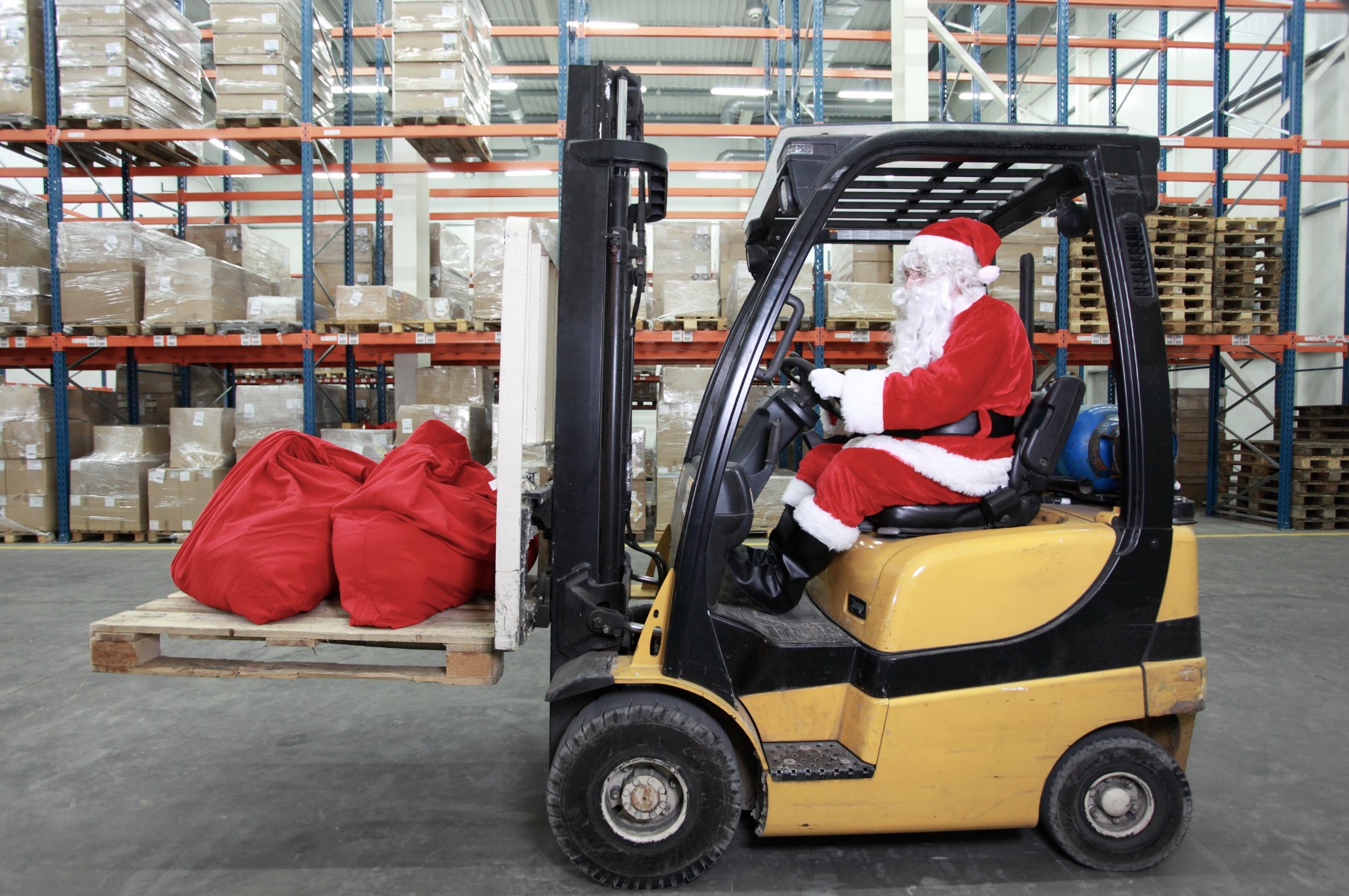

'Tis The Season To Be Automated: How is automation impacting the festive season?
Published: 24/12/2021
'Tis The Season To Be Automated: How is automation impacting the festive season?
Back in the early 2000s, Wizzard might have been asking for a daily supply of christmas, however we doubt Santa was wishing for the same thing. Relying on his workshop elves for production and simply himself for delivering the goods, transforming the festive period into a merry success was no easy feat.
Now with over two million children across the world and therefore increased demand, Santa is receiving an automated helping hand to bring joy to the world.

The Mechanics of Festive Automation
Tracking your assets is a pivotal cog in the distribution machine. As customers place orders and deliveries are prepared for shipment, stock visibility is key. Luckily, an Internet of Things system has this covered, able to track operations and data. These systems are integral for boosting connectivity and monitoring each and every product via tracking devices as it moves through the distribution chain.
Sensors have long proven themselves to keep their proverbial fingers on the pulse, providing vital live updates. Acting as a communication device between machines, these sensors indicate product location, temperature and overall status, often relating back to a human machine interface for ease of use. Imagine the horror of a manufacturing failure. With no sensors, the failure could go unrecognised for prolonged periods, meaning those Christmas gifts could very well fall victim to an undiagnosed maintenance issue. This would be neither merry nor bright for the intended recipient.
Automated manufacturing has long overtaken manual production methods, uniting man with machine to optimise the process. Capable of producing an equivalent number of gifts in a condensed time frame, when pitted against the elves alone, robotic manufacturing has taken the lead. Often referred to as collaborative robots or cobots, these intelligent devices greatly optimise operations and come in a variety of forms. Some machinery requires manual intervention whereby the operator will place the robotic device where it is required whereas others need a simple programme which even the less tech savvy amongst us could provide. These cobots hold the power to dramatically reduce physical workloads for warehouse employees, nullifying the need to pace up or down the production line and minimising the likelihood of workplace injuries. It is a fact of life that we are all human and each one of us is capable of making mistakes. With a correctly programmed robotic manufacturing process and preventative maintenance schedules firmly in place, the risk is minimised and the threat of downtime is curtailed.

The Benefits of Automated Supermarkets and Retailers
Gone are the days of solely manual warehouses where each pallet housed duplicates of a single item. Precision deliveries were nothing more than a pipe dream, however with the introduction of automation they have become a reality. Without automated intervention, this process would be far too time consuming but using robotics, the device is able to accurately select specific items and transfer them to the pallets, delivering to store exactly what is required and therefore reducing waste if the duplicate items had not been sold.
The click and collect option is a common choice when we are completing our Christmas shopping. Whether it be trying to get your hands on the last turkey crown or choosing those final stocking fillers, no one relishes the thought of a face to face battle in a supermarket aisle, hence the popularity of online shopping. While this has become an easier solution for those of us sitting at home clicking add to basket, for retail employees the opposite can be said. Once we place our orders, staff are then required to hit the shelves themselves, collecting the goods to dispatch. Employing an automated process not only alleviates this pressure but also means that shoppers are ordering directly from the warehouse. With a greater variety of products available, this also enhances the range on offer and lets robotic devices do all the work. After all, is there anything more frustrating than seeing the out of stock notification on your online bill and receiving a replacement item?
Out of stock items is one thing, however when goods are sitting in a warehouse, many items (specifically food produce) must be stored at specific temperatures to be safe for consumption. Having an automated process means less human intervention and with fewer people entering these optimised temperature storage facilities, perishable goods remain protected from external contamination. In a similar vein, if produce requires an extremely low storage temperature, this may be unsuitable for a human workforce, complicating the logistics significantly. Speaking of contamination, compliance with hygiene regulations is pivotal in the food supply industry. Could there be a worse ending to your Christmas than being struck down by a contaminated turkey and being bed ridden with food poisoning? Especially in light of the pandemic, how food is prepared and its journey to the festive buffet table is under more scrutiny than ever before. Including robotics in the process largely reduces the risk of contact with bacterial organisms.
If you have ever worked on a production line then you know the repetitive burden of the packaging stage all too well. With this in mind, many warehouses have opted to go automated, boosting consistency across the board. While we know it is what's inside that counts, no one can argue that a perfectly wrapped gift is a beautiful sight to behold. Void of human emotion, a robot can perform this arguably boring task, forming the box itself and adding the relevant labels in preparation for the festive season. This process can be performed in a matter of seconds, removing the monotony from work lives and allowing employees to develop their skills elsewhere. Often, those who once manually packaged the goods progress to overseeing the automated process. Have you ever received a giant box only to open it and discover your miniscule gift surrounded by a cushioning sea of bubble wrap? Automated solutions make these boxes to measure, meaning less waste and more compact designs. This lends itself to the actual delivery of goods, allowing more packages within a single truck meaning less journeys in total.

How has automation translated into icy, cold hard cash for Ocado and The Very Group during the Christmas period?
According to Statista, the demand for online shopping is on the rise. “In 2019/2020, an estimated 10% of male and female shoppers in the UK purchased food items over the internet once a week. In 2021, over 40% of shoppers in the UK even believed they would continue food shopping online at the same level as they do now once the pandemic is over.”
So, what does this demand mean for supermarkets and retailers and what part does automation have to play?
Ocado implement an automated supermarket solution, uniting man and machine.
"How we pack is critical to the economics of our business"
- Ocado's James Matthews
Selling their own produce and partnering with some of the UK’s supermarket giants such as Marks & Spencer, Ocado has become the country's largest solely online supermarket. With no physical stores, the pressure was on in the Ocado warehouses. Having high quantities of orders, Ocado were faced with manic packing and shipping and laborious shelf restocking. They needed speed without compromising on precision. They quickly realised that automation was the solution and so they created a sorting process which took the time down from two hours to five minutes when packing fifty items, reportedly the first of its kind. These robots use the technology mentioned above, controlled by a central computer, precisely pick groceries and navigate through a grid system to reach the packing destination. Better yet, it doesn't matter if it's a refrigerated turkey or a room temperature christmas pudding, the thousands of robotic devices paired with human assistance know no bounds. Ocado have been on the automation bandwagon for quite some time, embracing smart environments through the means of automated trolleys and conveyor belts. They later took to the streets of Woolwich to trial automated deliveries over a ten day period. As of 2021, Ocado have sealed the deal and invested in the self-driving Oxbotica, continuing to expand and develop their automated horizons.
The Very Group sales skyrocket: How did automation help fulfil the demand?
It’s not just supermarkets who are embracing automation. The retail sector has followed suit with a notable example being The Very Group. In December of last year, Very recorded their best festive trading year thus far, witnessing a staggering 25.2% increase in sales and almost the same increase in the number of customers, with mobile app sales up by 33%. As part of the group, Littlewoods was 18.1% ahead of their sales target during this period.
Very have now included automated processes in their business operations, assisting with the orders themselves and customer service. In March 2020, Very were busy preparing for the festive demand as they launched their Skygate state-of-the-art warehouse facility. As we placed orders, this warehouse allowed Very to process just under four million orders within seven weeks. At its highest capacity, this system processed 265 million orders in a single minute. In total, 7.8 million group deliveries were completed over the Christmas period.
More orders usually means more pressure on customer service employees, but Very incorporated a chatbot which was used by approximately 150,000 customers. No waiting for an available representative, just a speedy automated response to answer their pressing questions. Very have taken automation a step further to enhance the customer experience. Using automation, product recommendations are bespoke to each individual customer, determining each product by what the customer has already purchased. Having identified their buying habits, this tool acts as a virtual shopping assistant, pinpointing deals and allowing the customer to get their hands on their most sought after goodies.

But what happens when your automated process goes pop like a bottle of Buck’s Fizz?
No matter your automation requirements, Northern Industrial has you covered. From replacement sensors and HMIs to electrical repairs and spare parts, we do it all. Our mission is to save the world from downtime one part at a time.
So, if you experience system failure give the NI team a call and our engineers will be dashing through the snow to make sure all is calm and bright.
After all, all we want for Christmas is a fully functioning automated process, right?
Want to find out more?
If you'd like to learn more, click the button below and one of our helpful friendly team will be in touch. Alternately you can reach us by phone on +44 800 234 3747
Share this article




























